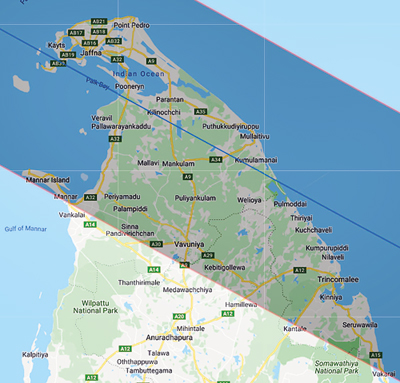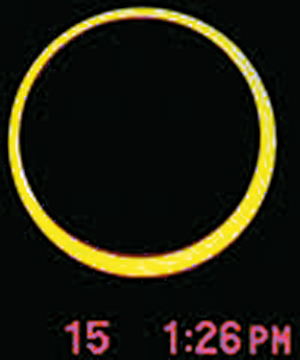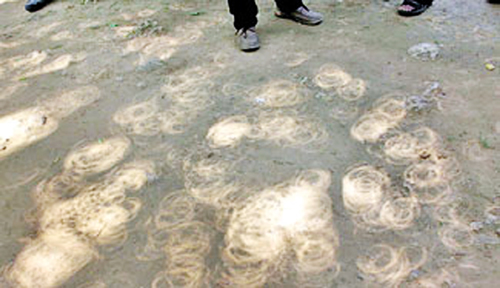Head to the North for annular solar eclipse

The path of the eclipse in the north
Eclipses have fascinated and frightened humans through recorded history. The oldest solar eclipse observation is a Chinese record dated 709 BCE. In the modern age when the Internet and TV can bring events to your home, you may wonder why some eclipse-chasers travel round the world to see an eclipse of the Sun. But a solar eclipse is an event which must be observed. No video shown on TV can do justice to this inspiring spectacle of nature.
The annular solar eclipse of December 26 which will be visible at 9.30 a.m. in Northern Lanka is a rare opportunity for Lankans. Although not as spectacular as a total eclipse, it is worth the travel to watch.
The annular eclipse will only be visible north of a line joining Mannar on the west coast and Vakarai on the east coast (see map) and crosses the A9 between Medawachchiya and Vavuniya.
The partial phase eclipse in Sri Lanka begins at 8.09 a.m. and ends 11:21 a.m. on Thursday, December 26. The annular phase will have a duration of three minutes from about 9.34 to 9.37 a.m. at an altitude of 40 degrees. The Moon will be seen in front of the Sun, leaving 6.5% of the Sun still visible as a bright ring.
 This timing will be up to five minutes later as you go to the east coast. From south of this border we will see only a partial eclipse. For example from Colombo, the Sun will be visible like a thin crescent.
This timing will be up to five minutes later as you go to the east coast. From south of this border we will see only a partial eclipse. For example from Colombo, the Sun will be visible like a thin crescent.
The centre line where the annularity is central goes through Kilinochchi and Pooneryn just south of Jaffna. Far from the centre-line the ring will appear non-symmetrical with one side much thinner. About a kilometre just north of the southern border, although the annularity will be very short, the Moon will graze the edge of the Sun, and one would observe interesting phenomena such a Bailey’s beads, resulting from Mountains on the Moon, not seen further in towards the centre-line.
Solar eclipses which happen somewhere on Earth each year are rare from any particular location. Over the 600-year period from 1500 to 2100 CE, it has been computed that three total solar eclipses and 11 annular solar eclipse paths crossed Lanka. However since the path is narrower than the island, from any one location in Lanka, there was only one total and 4 or 5 annular eclipses of the Sun.Northern Sri Lanka has been fortunate to have 3 of the annular eclipses in 2010 and 2019 and the next in 2031.

Rings on the ground: Multiple images of the crescent Sun as seen under a tree during the brief annular phase
The weather can always be a spoiler in watching any astronomical event. But as long as you can see the Sun you get a good view of an annular solar eclipse. Unlike in a total solar eclipse which requires it to be perfectly clear to see the corona, that in any case is not seen in an annular.
During the partial phase even if you are not in northern Lanka, look under a tree, and you will see multiple images of the crescent Sun made by the random pinholes made by the leaves as they flutter in the wind. During the brief annular phase these would be rings.
(The writer is an Astrophysicist)
| How to observe a solar eclipse | |
| It is never safe to look at the Sun, without the proper equipment and techniques. Even when 93% of the Sun’s surface is obscured during the annular phases of this solar eclipse, the remaining crescent Sun is still intense enough to cause permanent retinal damage, especially when viewed through binoculars or other optical aids.Unfiltered digital cameras will get destroyed. One can use electric welder’s glass available at many local hardware shops for under Rs. 60 as a filter. The recommended Shade 14 is not available in Lanka, but Shade 12 or 13 are OK.Although not as good as proper filters, the packaging used for milk powder can also be used since it is designed to keep out harmful UV light. The Highland brand has a white inner surface and you don’t see a reflection. These filters are opaque, other than when looking at the Sun, so if you can see anything else through them, it is not a good Solar filter.If used with an optical instrument such as a telescope or binoculars, the filtering MUST be at the objective BEFORE light enters the instrument. Make sure you don’t leave any pin holes.
|


